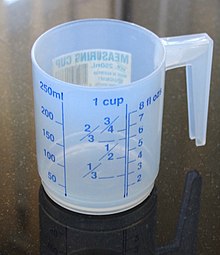
Back Volume Afrikaans आयतन ANP حجم Arabic قد ARY Volume AST Həcm Azerbaijani Күләм Bashkir Bolyum BCL Аб’ём Byelorussian Аб’ём BE-X-OLD
| Volume | |
|---|---|
 A measuring cup can be used to measure volumes of liquids. This cup measures volume in units of cups, fluid ounces, and millilitres. | |
Common symbols | V |
| SI unit | cubic metre |
Other units | Litre, fluid ounce, gallon, quart, pint, tsp, fluid dram, in3, yd3, barrel |
| In SI base units | m3 |
| Extensive? | yes |
| Intensive? | no |
| Conserved? | yes for solids and liquids, no for gases, and plasma[a] |
Behaviour under coord transformation | conserved |
| Dimension | L3 |
Volume is a measure of regions in three-dimensional space.[1] It is often quantified numerically using SI derived units (such as the cubic metre and litre) or by various imperial or US customary units (such as the gallon, quart, cubic inch). The definition of length and height (cubed) is interrelated with volume. The volume of a container is generally understood to be the capacity of the container; i.e., the amount of fluid (gas or liquid) that the container could hold, rather than the amount of space the container itself displaces. By metonymy, the term "volume" sometimes is used to refer to the corresponding region (e.g., bounding volume).[2][3]
In ancient times, volume was measured using similar-shaped natural containers. Later on, standardized containers were used. Some simple three-dimensional shapes can have their volume easily calculated using arithmetic formulas. Volumes of more complicated shapes can be calculated with integral calculus if a formula exists for the shape's boundary. Zero-, one- and two-dimensional objects have no volume; in four and higher dimensions, an analogous concept to the normal volume is the hypervolume.
Cite error: There are <ref group=lower-alpha> tags or {{efn}} templates on this page, but the references will not show without a {{reflist|group=lower-alpha}} template or {{notelist}} template (see the help page).
- ^ "SI Units - Volume". National Institute of Standards and Technology. April 13, 2022. Archived from the original on August 7, 2022. Retrieved August 7, 2022.
- ^ "IEC 60050 — Details for IEV number 102-04-40: "volume"". International Electrotechnical Vocabulary (in Japanese). Retrieved 2023-09-19.
- ^ "IEC 60050 — Details for IEV number 102-04-39: "three-dimensional domain"". International Electrotechnical Vocabulary (in Japanese). Retrieved 2023-09-19.